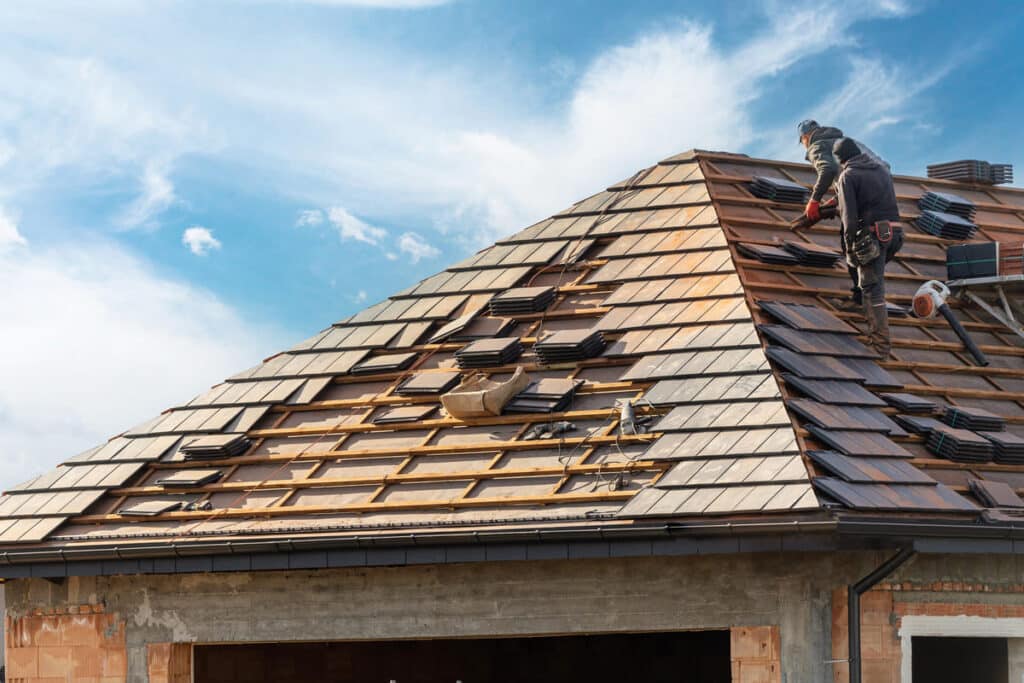Massachusetts winters are tough on roofs. Heavy snow, freezing rain, and sudden temperature swings put a lot of stress on them. If your roof is already showing signs of age or wear, the cold months ahead can turn small problems into costly emergencies. Knowing when to replace your roof shingles or the entire system is critical to protecting your home and your family. This guide will help you recognize the most important warning signs so you can act before winter hits.
Your Roof’s Age Matters

The age of your roof is one of the most important factors that helps to decide if replacement is due. Most asphalt shingle roofs last around 20 to 25 years, but New England weather often shortens that timeline. Three-tab shingles usually last 15 to 20 years, while today’s architectural shingles can hold up for as long as 50 years. In Massachusetts, cold winters, wet springs, and humid summers all make roofs age faster.
If your roof is past the 15- to 20-year mark, it’s wise to plan ahead, rather than wait for leaks or major failures. Roof replacement before winter gives you peace of mind and avoids the stress of mid-season repairs.
Signs You Need a New Roof
Some roof problems are easy to spot, but you have to pay attention. These visible signs usually indicate your roof is failing and needs professional attention.

Curling or Buckling Shingles
Shingles that curl at the edges or bulge in the middle can no longer protect your home. Heat, trapped moisture, or simple aging can cause this. Once shingles start to lift or twist, your roof is open to leaks.
Missing Shingles
Strong winds, hailstorms, or poor installation can loosen shingles. When they go missing, the roof deck is left exposed. Massachusetts storms can quickly strip shingles, which makes way for leaks, insulation problems, and even damage to the structure of your home.
Water Stains or Interior Leaks
Brown or yellow stains on ceilings and walls are a clear sign of leakage. Even a tiny leak from damaged shingles or loose flashing can spread fast. If you spot stains or peeling paint, get your roof inspected and replace your roof if needed.
Sagging Roof
An uneven or drooping roof is a serious warning sign. It points to water damage, decaying wood, or too much snow or ice. This can weaken the structure of the building and end with a collapsed roof during a heavy storm.
Granules in Gutters
If you find black, sand-like granules in your gutters, then your shingles may be wearing out. These granules shield shingles from UV rays and rain. Without them, shingles dry out, crack, and fail more quickly.
Mold, Moss, or Algae Growth
Moss, algae, and those black streaks you see love damp and shaded areas. They hold moisture against your roof, which can separate shingles or remove their protective coating. Over time, they weaken your roof and make it more prone to leaks.
Daylight in the Attic
Go into your attic during the day and turn off the lights. If you see daylight peeking through, your roof has gaps or cracks. These openings allow water and cold air in and heat out.
Cracked or Damaged Flashing
Flashing seals the areas around chimneys, skylights, and vents. If it’s cracked, rusted, or pulling away, water can seep inside. Older flashing materials break down faster, and storm damage can make the problem worse. If you see rust or gaps, replacement is likely needed.
Massachusetts Winter Challenges
Even small roofing issues can worsen quickly once winter weather sets in. Massachusetts homeowners face unique problems that make timing critical.

Ice Dams
When heat escapes into the attic, it warms the roof, melting snow that then refreezes at the eaves. This creates ice dams that trap water behind them. Ice dams are common in older homes with poor insulation and can lead to leaks and roof deck damage.
Heavy Snow Loads
Due to excessive snowy conditions in winter, most towns and cities in Massachusetts must be built to support at least 25 to 40 pounds of snow per square foot on flat roofs. After a nor’easter, your roof may be carrying several tons of weight. A weak or aging roof can definitely fail under this pressure.
Freeze-Thaw Cycles
When water seeps into cracks and freezes, it expands, making the damage worse. The constant freezing and thawing we get in New England winters weakens shingles, flashing, and other materials. This speeds up roof failure.
Poor Ventilation
Warm air can get stuck in your attic without good airflow, which can lead to ice dams. U.S. Federal Housing Authority suggests having 1 square foot of vent area for every 300 square feet of attic space. In Massachusetts, an attic R-value of 48 is a solid target to keep homes warm and reduce winter damage.
Why Timing Matters
Replacing your roof before winter is not only safer but also more cost-effective. Fall’s usually the best time to do it since the weather’s milder and easier to predict. Crews can complete installations without delays from ice or snow. It is possible to replace your roof in winter, but it’s more challenging, and material performance can suffer in freezing conditions. Taking care of things now means you won’t have to deal with emergency repairs when it’s freezing.
Making the Right Decision
If your roof shows any of the warning signs, it’s time to consider your options. Sometimes small repairs can buy a little time, but repeated fixes generally cost more in the long run. A full roof replacement is an investment in your home’s safety, energy efficiency, and value.
For your peace of mind, choose a local, licensed, and insured roofing contractor who’s familiar with Massachusetts’ weather conditions. As a local residential and commercial roofing expert, we at Beantown Home Improvements know the unique demands of New England winters and are aware of materials that hold up in such harsh conditions.
Protect Your Home Before Winter
Ignoring warning signs now can lead to water damage, higher energy bills, and costly repairs. Whether it’s a commercial or residential roof, if it’s more than 15 years old, then you need to schedule an inspection today and let the experts take action before winter arrives.
